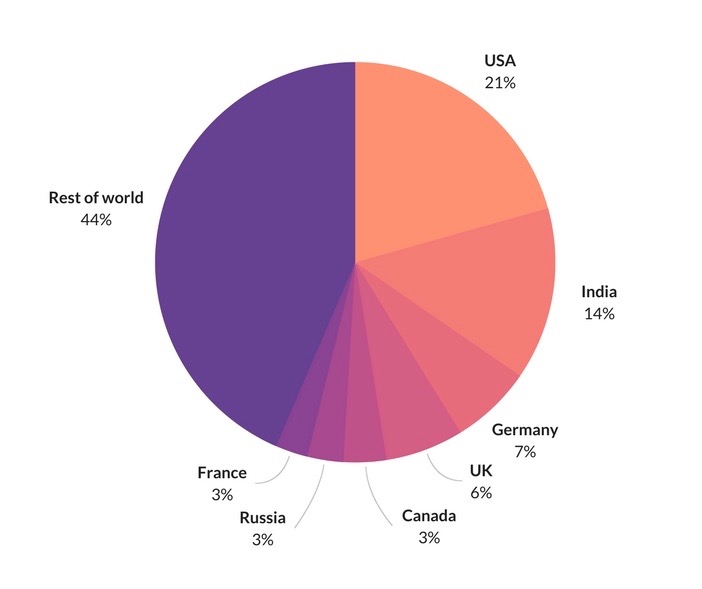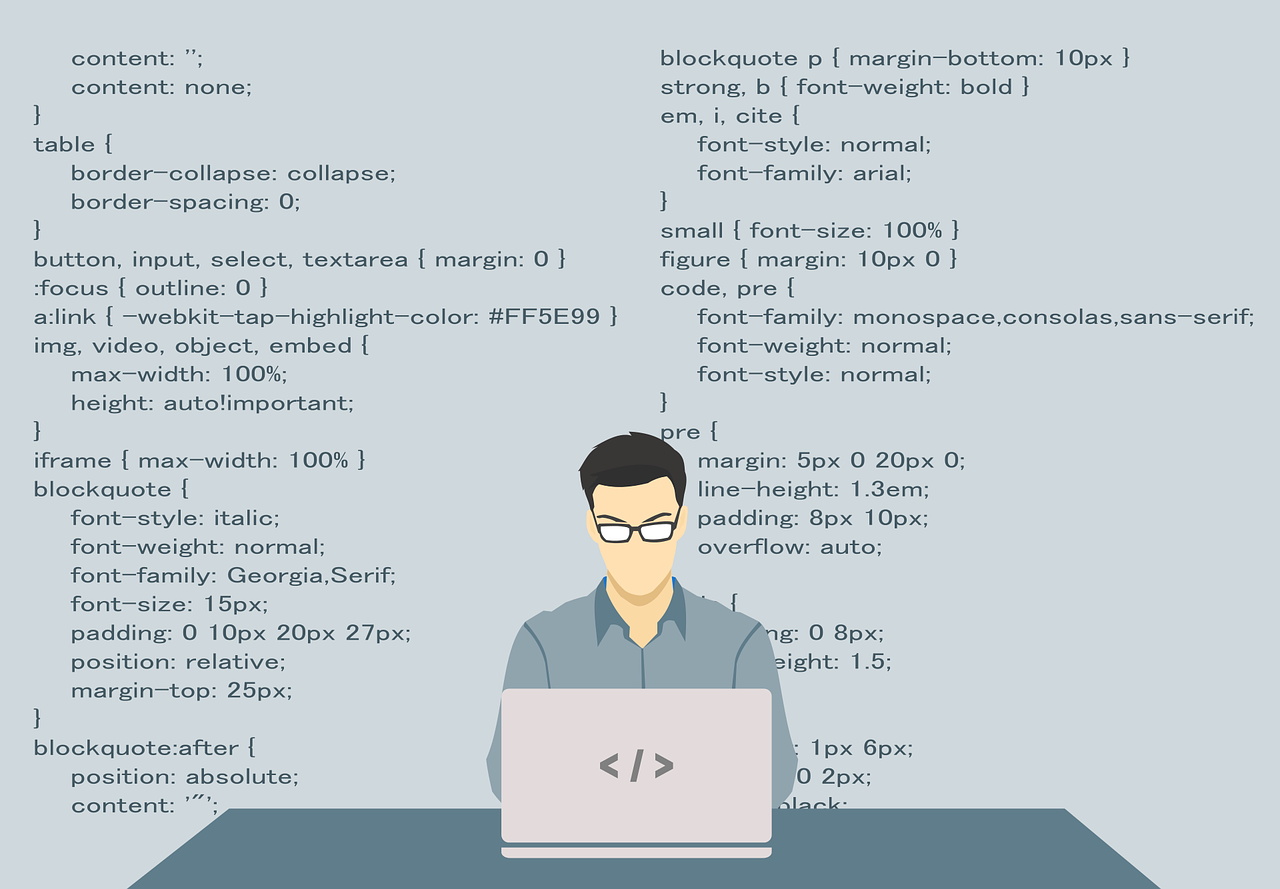This year’s 2018 Stack Overflow Developer Survey analysed responses from 101,592 developers from 183 countries around the world. It’s the 8th year of the survey and the largest pool of respondents ever. In this post, we explore the 5 key findings and some interesting stats that arose from the survey, such as common education paths and developers’ favorite and least favorite technologies.
5 Key Findings
Here are the five takeaway findings from this year’s survey.
- Developers working in the fields of DevOps and Machine Learning get paid the highest salaries. Opportunities in the languages and frameworks of these two fields are on the rise.
- 87% of developers are at least, in part, self-taught. Most have taught themselves a new language, framework, or tool outside of any formal education. Online education is more common (48,6%) than full-time face-to-face learning (10,5%).
- There is optimism about the possibilities offered by artificial intelligence (AI), but a lack of agreement about the dangers.
- Python is becoming increasingly popular as a programming language: it has overtaken C# this year.
- There are gender differences when it comes to assessing prospective jobs. For women, the most important thing is company culture and professional development opportunities. Men, however, look at compensation, and the particular technologies that form part of the job.
Profile of Respondents
Geographically, the respondents come from all over the world: the largest contingent are in the US (20,65%), followed by India (13,95%). However, many countries are represented including Germany (6,57%), the UK (6,32%), and France (2,61%).

As far as potential jobs go, approximately 60% of respondents are back-end developers and about 48% work as full-stack developers, but a wide variety of jobs are represented including mobile developers, database administrators, games or graphics developers, DevOps specialists, etc.
Experience levels varied between respondents. However, a full third learnt to code only within the last five years. More than 50% have five years or less of professional programming experience.
Education
Only 46% of respondents have a Bachelor’s degree, and it is fairly common to find accomplished programmers who haven’t completed a formal degree.
The one thing that is consistent among developers is that they tend to be lifelong learners. Outside of any formal education, 87% of them have taught themselves a new language, framework or tool. As far as online courses go, 48,6% have completed such a course. Approximately 25% have taken part in a hackathon, a day-long coding competition where computer programmers come together to code, design, and build something, whether it’s a website or a mobile app.
Lifelong learners
Developers are lifelong learners; almost 87% of all developers say they have taught themselves a new language, framework, or tool outside of their formal education. Among professional developers, almost half say they have taken an online course like a MOOC, and about a quarter have participated in a hackathon.
Here’s a graph showing how professional programmers have educated themselves:

Source: https://insights.stackoverflow.com/survey/2018#developer-profile-other-types-of-education
Bootcamps
Interestingly, if one compares online courses with bootcamps, which tend to take place in a specific location face-to face, it seems online education is more common – 48,6% have taken up online courses versus 10,5% for full-time physical developer training bootcamps.
Although bootcamps are seen as a way for people new to the industry to gain entry in a short period of time, they are also very appealing for those already in the industry: almost 50% of those surveyed who attended a coding bootcamp already had jobs as developers. Their reasons for enrolling on a bootcamp included the desire to learn new areas of technology and to update their current skills. About 82% of respondents who attended a bootcamp found work within six months of finishing their course.
Here’s a graph showing how long it took programmers to find a job after attending a bootcamp:

Technology
It’s always fascinating to see which technologies are most in-demand and which are dreaded. JavaScript is the programming language that is most commonly used. This has remained unchanged for six years in a row! Second up is HTML, followed by CSS.
Python is on the up: last year it overtook PHP and this year it has surpassed C#. Python, says David Robinson on the Stack Overflow blog, has ‘a solid claim to being the fastest-growing major programming language.’ The top three programming languages, plus Python, form part of HyperionDev’s Full Stack Web Developer course.
Here’s a graph of the most popular programming, scripting and markup languages:

Source: https://insights.stackoverflow.com/survey/2018#technology-programming-scripting-and-markup-languages
When it comes to frameworks, libraries and tools, the technologies used most frequently are Node.js and Angular JS, while React and .Net Core remain integral to developers. Unsurprisingly, MySQL and SQL Server, same as last year, maintain their top spots for most commonly used databases.
Most Loved, Dreaded and Wanted
What does love mean for a developer? It means that he or she wants to continue working with a particular language. The most loved programming language for 2018 is Rust, an open-source, low-level language, ideally suited for systems, which runs blazingly fast. Kotlin is the second most loved language and Python comes in at third.
The most dreaded languages are those that developers have no interest in carrying on using, even if they are currently working with them. Visual Basic 6 tops the list – for the third year in a row! Cobol and CoffeeScript come second and third respectively.
When it comes to languages that are wanted – i.e. developers are not yet using that language, but they are very keen to learn it – Python cames in at #1 for the second year in a row. This is followed by JavaScript: 19% of all respondents want to learn this language.
The Top Five: Love, Dreaded, Wanted
Five Top Loved Languages

Five Top Dreaded Languages

Five Top Wanted Languages

Source: https://insights.stackoverflow.com/survey/2018#technology-most-loved-dreaded-and-wanted-languages
Top-Paying Technologies
Which languages are associated with the highest salaries? Globally, F#, Ocami, Clojure and Groovy have median salaries above $70 000 USD, and are the highest. The F# Software Foundation can tell you more about this computer language.
However, in the US the top-paying salaries are for developers who know Erlang ($115 000 per annum) and Scala ($115 000 per annum). Among more common programming languages, the top US earners are developers conversant in Java ($100 000 per annum), C ($98 000 per annum), JavaScript ($98 000 per annum) and Python ($98 000 per annum).
The average salary in the US, for non-programmers, is much lower – almost half of what developers make on average! For those between the ages of 20 and 24, the average salary per annum is $27 456. Older people fare slightly better: between the ages of 25 and 34, you can expect an average salary of $39 416 and those between 35 and 44 earn, on average, $49 400. The best annual salary, $50 024, is earned by 45 to 54 year-olds.
How Do Developers Feel About the Future of AI
Developers were asked what they found dangerous and exciting about the future of AI. When it came to danger, there wasn’t much consensus. Each of the following factors were considered equivalently dangerous: algorithms making important decisions, AI moving ahead of human intelligence, evolving decisions of ‘fairness’ when it came to algorithmic versus human decisions, and increasing automation of jobs. As far as excitement went, 40,8% of developers noted the increasing automation of jobs.
Although most developers could identify dangerous aspects when thinking about the future of AI, there was still a general degree of optimism about what AI offers the world, with almost three quarters of developers stating that they were more excited than worried.
Employment
When it come number of developers employed, the stats look very positive: over 90% of developers are, at least part-time, employed.

Source: https://insights.stackoverflow.com/survey/2018#work-employment-status
Company Type and Size
Developers are employed in a very wide range of industries. However, most developers, approximately 38%, work in web development, information technology or SaaS (Software as a service, including software development. Other industries include: financial technology (8,7%), cloud based solutions (7,1%), data and analytics (5,7%), consulting (5,3%), etc.
Interestingly, developers working in certain industries, such as consulting and healthcare, tend to have more years of coding experience. Compared with web development or eCommerce, developers in the consulting and healthcare industries are twice as likely to have more than 20 years experience.
Although companies vary in size, US developers tend to work in larger companies than elsewhere in the world. Also, more experienced developers are more likely to work in larger companies.
Here’s a graph showing the percentage of developers in different-sized companies:

Source: https://insights.stackoverflow.com/survey/2018#work-company-size
The Five-Year Plan
If programmers are asked where they would like to be in five years time, just more than 50% are keen to remain in their current role, or, alternatively, another technical role. About 25% want to start their own company, but this sentiment is more likely to be expressed by developers younger than 25. Only 2,8% would like to work in a field completely unrelated to software development.
How Do Developers Feel About Their Jobs?
Some interesting results emerge here. These are the trends:
- Developers experience greater satisfaction with their career than their current job.
- Job satisfaction is significantly lower in financial services and IT.
- The highest career satisfaction is experienced by older developers, aged 50 or higher, and those with 20-30 years experience.
- Job satisfaction, on the other hand, peaks for developers between 35 and 44 years of age.
Last Job Change

As you can see, frequent job changes are the norm for software developers.
Assessing Potential Jobs
When assessing potential jobs, 28,3% of developers focus on the compensation and benefits offered. The languages, frameworks and other technologies involved in the work are also strongly considered, as well as opportunities for professional development. Low priority consideration include the diversity of the organisation and the financial performance or funding status of the company.
Salary by Developer Type
As far as salaries go, Engineering managers, at $137 000 per annum, earn the highest in the US. Coming close on their heels are DevOps specialists, who earn $110 000 per annum and back-end developers at $102 000 per year. Back-end developers draw with data scientists or machine learning specialists.
Here’s a graph showing the different salaries for various types of developers:

Source: https://insights.stackoverflow.com/survey/2018#work-salary-by-developer-type
In conclusion, the Stack Overflow Developer Survey 2018 reveals many interesting findings. Perhaps of greatest relevance to developers and those wanting to enter this field is that learning never stops. Developers are lifelong learners. Also worth noting is that developers are, by and large, satisfied in their chosen field. It’s clear that developers are in an exciting career that offers a great deal of change and stimulation.


